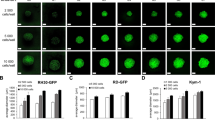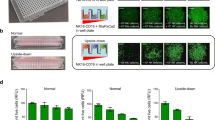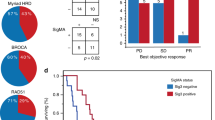Abstract
Immune checkpoint inhibitors (ICIs) that target programmed cell death protein 1 (PD-1) and programmed death-ligand 1 (PD-L1) have shown modest activity as monotherapies for the treatment of ovarian cancer (OC). The rationale for using these therapies in combination with poly (ADP-ribose) polymerase inhibitors (PARP-Is) has been described, and their in vivo application will benefit from ex vivo platforms that aid in the prediction of patient response or resistance to therapy. This study examined the effectiveness of detecting patient-specific immune-related activity in OC using three-dimensional (3D) spheroids. Immune-related cell composition and PD-1/PD-L1 expression status were evaluated using cells dissociated from fresh OC tissue from two patients prior to and following 3D culture. The patient sample with the greatest increase in the proportion of PD-L1 + cells also possessed more activated cytotoxic T cells and mature DCs compared to the other patient sample. Upon cytokine stimulation, patient samples demonstrated increases in cytotoxic T cell activation and DC major histocompatibility complex (MHC) class-II expression. Pembrolizumab increased cytokine secretion, enhanced olaparib cytotoxicity, and reduced spheroid viability in a T cell-dependent manner. Furthermore, durvalumab and olaparib combination treatment increased cell death in a synergistic manner. This work demonstrates that immune cell activity and functional modulation can be accurately detected using our ex vivo 3D spheroid platform, and it presents evidence for their utility to demonstrate sensitivity to ICIs alone or in combination with PARP-Is in a preclinical setting.







Similar content being viewed by others
Data availability
The datasets used and/or analyzed during the current study are available from the corresponding author on reasonable request.
Abbreviations
- 3D:
-
Three-dimensional
- BRCA1/2:
-
Breast-related cancer antigens 1 and 2
- DC:
-
Dendritic cells
- GM-CSF:
-
Granulocyte–macrophage colony-stimulating factor
- ICI:
-
Immune checkpoint inhibitor
- IRB:
-
Institutional Review Board
- IFNγ:
-
Interferon gamma
- IL-2:
-
Interleukin-2; IL-10: Interleukin-10
- IL-10:
-
IFNγ-induced protein 10
- MIP-1α:
-
Macrophage inflammatory protein
- MHC:
-
Major histocompatibility complex
- MHC-II:
-
Major histocompatibility complex class-II
- OC:
-
Ovarian cancer
- PBMCs:
-
Peripheral blood mononuclueated cells
- PARP-I:
-
Poly (ADP-ribose) polymerase inhibitors
- PD-1:
-
Programmed cell death protein 1
- PD-L1:
-
Programmed death-ligand 1
- RLUs:
-
Relative luminescence units
- SD:
-
Standard deviation
- T cell CM:
-
T cell expansion media
- TILs:
-
Tumor-infiltrating lymphocytes
- TIME:
-
Tumor immune microenvironment
- TNFα:
-
Tumor necrosis factor alpha
- Tregs:
-
Regulatory T cells
- VC:
-
Vehicle control
References
Siegel RL, Miller KD, Jemal A (2020) Cancer statistics, 2020. CA Cancer J Clin 70(1):7–30
Pantelidou C, Sonzogni O, De Oliveria TM, Mehta AK, Kothari A, Wang D et al (2019) PARP inhibitor efficacy depends on CD8(+) T-cell recruitment via intratumoral STING pathway activation in BRCA-deficient models of triple-negative breast cancer. Cancer Discov 9(6):722–737
Zhang L, Conejo-Garcia JR, Katsaros D, Gimotty PA, Massobrio M, Regnani G et al (2003) Intratumoral T cells, recurrence, and survival in epithelial ovarian cancer. N Engl J Med 348(3):203–213
Zhang G, Liu C, Bai H, Cao G, Cui R, Zhang Z (2019) Combinatorial therapy of immune checkpoint and cancer pathways provides a novel perspective on ovarian cancer treatment. Oncol Lett 17(3):2583–2591
Ghisoni E, Imbimbo M, Zimmermann S, Valabrega G (2019) Ovarian cancer immunotherapy: turning up the heat. Int J Mol Sci. 20(12):2927
Matulonis UA, Shapira-Frommer R, Santin AD, Lisyanskaya AS, Pignata S, Vergote I et al (2019) Antitumor activity and safety of pembrolizumab in patients with advanced recurrent ovarian cancer: results from the phase II KEYNOTE-100 study. Ann Oncol 30(7):1080–1087
Shuford S, Wilhelm C, Rayner M, Elrod A, Millard M, Mattingly C et al (2019) Prospective validation of an Ex Vivo, patient-derived 3d spheroid model for response predictions in newly diagnosed ovarian cancer. Scientific Reports 9(1):11153
Wang Z, Sun K, Xiao Y, Feng B, Mikule K, Ma X et al (2019) Niraparib activates interferon signaling and potentiates anti-PD-1 antibody efficacy in tumor models. Sci Rep 9(1):1853
Konstantinopoulos PA, Waggoner S, Vidal GA, Mita M, Moroney JW, Holloway R et al (2019) Single-arm phases 1 and 2 trial of niraparib in combination with pembrolizumab in patients with recurrent platinum-resistant ovarian carcinoma. JAMA Oncol 5(8):1141–1149
Farkkila A, Gulhan DC, Casado J, Jacobson CA, Nguyen H, Kochupurakkal B et al (2020) Immunogenomic profiling determines responses to combined PARP and PD-1 inhibition in ovarian cancer. Nat Commun 11(1):1459
Boussios S, Karihtala P, Moschetta M, Karathanasi A, Sadauskaite A, Rassy E et al (2019) Combined Strategies with Poly (ADP-Ribose) Polymerase (PARP) Inhibitors for the treatment of ovarian cancer: a literature review. Diagnostics (Basel) 9(3):87
Jiang X, Li X, Li W, Bai H, Zhang Z (2019) PARP inhibitors in ovarian cancer: Sensitivity prediction and resistance mechanisms. J Cell Mol Med 23(4):2303–2313
Ding L, Kim HJ, Wang Q, Kearns M, Jiang T, Ohlson CE et al (2018) PARP inhibition elicits sting-dependent antitumor immunity in brca1-deficient ovarian cancer. Cell Rep. 25(11):2972–2980
Zimmer AS, Nichols E, Cimino-Mathews A, Peer C, Cao L, Lee MJ et al (2019) A phase I study of the PD-L1 inhibitor, durvalumab, in combination with a PARP inhibitor, olaparib, and a VEGFR1-3 inhibitor, cediranib, in recurrent women’s cancers with biomarker analyses. J Immunother Cancer 7(1):197
Shuford S, Wilhelm C, Rayner M, Elrod A, Millard M, Mattingly C et al (2019) Prospective validation of an ex vivo, patient-derived 3d spheroid model for response predictions in newly diagnosed ovarian cancer. Sci Rep 9(1):11153
Riedl A, Schlederer M, Pudelko K, Stadler M, Walter S, Unterleuthner D et al (2017) Comparison of cancer cells in 2D vs 3D culture reveals differences in AKT-mTOR-S6K signaling and drug responses. J Cell Sci 130(1):203–218
Kapalczynska M, Kolenda T, Przybyla W, Zajaczkowska M, Teresiak A, Filas V et al (2018) 2D and 3D cell cultures-a comparison of different types of cancer cell cultures. Arch Med Sci 14(4):910–919
Di Veroli GY, Fornari C, Wang D, Mollard S, Bramhall JL, Richards FM et al (2016) Combenefit: an interactive platform for the analysis and visualization of drug combinations. Bioinformatics 32(18):2866–2868
Ingulli E, Mondino A, Khoruts A, Jenkins MK (1997) In vivo detection of dendritic cell antigen presentation to CD4(+) T cells. J Exp Med 185(12):2133–2141
Norbury CC, Malide D, Gibbs JS, Bennink JR, Yewdell JW (2002) Visualizing priming of virus-specific CD8+ T cells by infected dendritic cells in vivo. Nat Immunol 3(3):265–271
Mayoux M, Roller A, Pulko V, Sammicheli S, Chen S, Sum E et al (2020) Dendritic cells dictate responses to PD-L1 blockade cancer immunotherapy. Sci Transl Med 12(534):eaav7431
Versteven M, Van den Bergh JMJ, Marcq E, Smits ELJ, Van Tendeloo VFI, Hobo W et al (2018) Dendritic cells and programmed death-1 blockade: a joint venture to combat cancer. Front Immunol 9:394
Flies DB, Higuchi T, Harris JC, Jha V, Gimotty PA, Adams SF (2016) Immune checkpoint blockade reveals the stimulatory capacity of tumor-associated CD103(+) dendritic cells in late-stage ovarian cancer. Oncoimmunology 5(8):e1185583
Broz ML, Binnewies M, Boldajipour B, Nelson AE, Pollack JL, Erle DJ et al (2014) Dissecting the tumor myeloid compartment reveals rare activating antigen-presenting cells critical for T cell immunity. Cancer Cell 26(6):938
Salmon H, Idoyaga J, Rahman A, Leboeuf M, Remark R, Jordan S et al (2016) Expansion and activation of CD103(+) dendritic cell progenitors at the tumor site enhances tumor responses to therapeutic PD-L1 and BRAF inhibition. Immunity 44(4):924–938
Dennis KL, Blatner NR, Gounari F, Khazaie K (2013) Current status of interleukin-10 and regulatory T-cells in cancer. Curr Opin Oncol 25(6):637–645
Shi Y, Liu CH, Roberts AI, Das J, Xu G, Ren G et al (2006) Granulocyte-macrophage colony-stimulating factor (GM-CSF) and T-cell responses: what we do and don’t know. Cell Res 16(2):126–133
Parameswaran N, Patial S (2010) Tumor necrosis factor-alpha signaling in macrophages. Crit Rev Eukaryot Gene Expr 20(2):87–103
Maurer M, von Stebut E (2004) Macrophage inflammatory protein-1. Int J Biochem Cell Biol 36(10):1882–1886
Han Q, Bagheri N, Bradshaw EM, Hafler DA, Lauffenburger DA, Love JC (2012) Polyfunctional responses by human T cells result from sequential release of cytokines. Proc Natl Acad Sci U S A 109(5):1607–1612
Ahamadi M, Freshwater T, Prohn M, Li CH, de Alwis DP, de Greef R et al (2017) Model-based characterization of the pharmacokinetics of pembrolizumab: a humanized anti-pd-1 monoclonal antibody in advanced solid tumors. CPT Pharmacometrics Syst Pharmacol 6(1):49–57
Lee JM, Cimino-Mathews A, Peer CJ, Zimmer A, Lipkowitz S, Annunziata CM et al (2017) Safety and clinical activity of the programmed death-ligand 1 inhibitor durvalumab in combination with poly (ADP-Ribose) polymerase inhibitor olaparib or vascular endothelial growth factor receptor 1–3 inhibitor cediranib in women’s cancers: a dose-escalation. Phase I Study J Clin Oncol 35(19):2193–2202
Baverel PG, Dubois VFS, Jin CY, Zheng Y, Song X, Jin X et al (2018) Population pharmacokinetics of durvalumab in cancer patients and association with longitudinal biomarkers of disease status. Clin Pharmacol Ther 103(4):631–642
Merlano MC, Abbona A, Denaro N, Garrone O (2019) Knowing the tumour microenvironment to optimise immunotherapy. Acta Otorhinolaryngol Ital 39(1):2–8
Binnewies M, Roberts EW, Kersten K, Chan V, Fearon DF, Merad M et al (2018) Understanding the tumor immune microenvironment (TIME) for effective therapy. Nat Med 24(5):541–550
Filipovic A, Miller G, Bolen J (2020) Progress toward identifying exact proxies for predicting response to immunotherapies. Front Cell Dev Biol 8:155
Cai DL, Jin LP (2017) Immune cell population in ovarian tumor microenvironment. J Cancer 8(15):2915–2923
Heong V, Ngoi N, Tan DS (2017) Update on immune checkpoint inhibitors in gynecological cancers. J Gynecol Oncol 28(2):e20
Alexandrov LB, Nik-Zainal S, Wedge DC, Aparicio SA, Behjati S, Biankin AV et al (2013) Signatures of mutational processes in human cancer. Nature 500(7463):415–421
Maleki VS (2018) High and low mutational burden tumors versus immunologically hot and cold tumors and response to immune checkpoint inhibitors. J Immunother Cancer 6(1):157
Varga A, Piha-Paul S, Ott PA, Mehnert JM, Berton-Rigaud D, Morosky A et al (2019) Pembrolizumab in patients with programmed death ligand 1-positive advanced ovarian cancer: analysis of KEYNOTE-028. Gynecol Oncol 152(2):243–250
Turner N, Tutt A, Ashworth A (2004) Hallmarks of “BRCAness” in sporadic cancers. Nat Rev Cancer 4(10):814–819
Jiang X, Li W, Li X, Bai H, Zhang Z (2019) Current status and future prospects of PARP inhibitor clinical trials in ovarian cancer. Cancer Manag Res 11:4371–4390
Di Modugno F, Colosi C, Trono P, Antonacci G, Ruocco G, Nistico P (2019) 3D models in the new era of immune oncology: focus on T cells, CAF and ECM. J Exp Clin Cancer Res 38(1):117
Schnell A, Schmidl C, Herr W, Siska PJ (2018) The peripheral and intratumoral immune cell landscape in cancer patients: a proxy for tumor biology and a tool for outcome prediction. Biomedicines. 6(1):25
Acknowledgements
The authors would like to thank the patients for their participation in this study. We would also like to extend our appreciation to the ITOR Biorepository at Prisma Health for their support.
Funding
All work for this study was funded by KIYATEC, Inc.
Author information
Authors and Affiliations
Contributions
KMA designed the study, performed the experiments and data analysis, and wrote the manuscript; AKE performed the experiments, and wrote the manuscript; KL performed flow cytometry and immunofluorescence for cytokine stimulation experiments, and provided experimental design assistance; SS provided experimental design assistance and data review; LMH provided facilities/logistics for experimental performance; TMD directed the project, provided data review, and wrote the manuscript. All authors read and approved the final manuscript.
Corresponding author
Ethics declarations
Conflict of interest
Dr. Appleton, Ms. Elrod, Ms. Lassahn, Mr. Shuford, Ms. Holmes, and Dr. DesRochers are current employees of KIYATEC, Inc.
Ethical approval
Written informed consent was obtained from patients in accordance with the Institutional Review Board (IRB)-approved biology protocols by Prisma Health, formally known as Greenville Health System, Cancer Institute (IRB-Committee C).
Additional information
Publisher's Note
Springer Nature remains neutral with regard to jurisdictional claims in published maps and institutional affiliations.
Supplementary information
Below is the link to the electronic supplementary material.
Rights and permissions
About this article
Cite this article
Appleton, K.M., Elrod, A.K., Lassahn, K.A. et al. PD-1/PD-L1 checkpoint inhibitors in combination with olaparib display antitumor activity in ovarian cancer patient-derived three-dimensional spheroid cultures. Cancer Immunol Immunother 70, 843–856 (2021). https://doi.org/10.1007/s00262-021-02849-z
Received:
Accepted:
Published:
Issue Date:
DOI: https://doi.org/10.1007/s00262-021-02849-z




